A while back I was invited by the Nashville Home Show to share some green living ideas at their Music City Center show. What is green living? Well, it is living in a more sustainable environmentally friendly way. Being passionate about making green choices, I am happy to take the opportunity to share ideas for lessening our environmental impact. I like to hope that I was able to inspire a few of the thousands of attendees from the metro area to go a little greener. Lots of small actions add up to produce big results so I hope you will join us in a more eco friendly lifestyle as well! Here are some sustainable living ideas for a greener world to get you started.
Green Living Meaning
But first, what is green living? Green living refers to a lifestyle that aims to reduce an individual’s or community’s environmental impact by making choices that are more sustainable and eco-friendly. The goal of green living is to minimize the depletion of natural resources, reduce pollution, and promote the health and well-being of the planet and its inhabitants.
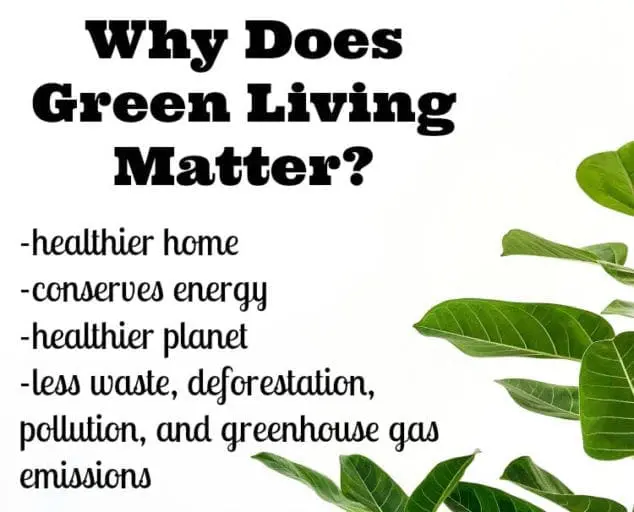
Why Does Living Green Matter?
On a personal level, I just love nature and I want to do all I can do respect it and preserve it. That is why I pursue a sustainable lifestyle and try to lower my carbon footprint. Our choices and actions have a direct impact on our environment and I want to help keep it beautiful and healthy to live in. Green living is nice on a personal level because it means a healthier home that is conserving resources and it is nice on a global level because it means a healthier planet with less waste, deforestation, pollution, and greenhouse gas emissions.

Sustainable Living Ideas For Your Home
Now that we can see how important green living is, I decided to divide my green living ideas into three areas that will help you go greener in your homes. I want to focus on easy green living tips today that you can implement without huge lifestyle changes or huge investments because I don’t want anything to stand in your way. I want you to take these green living ideas as inspiration and run with them.
There are so many ways to go green and I often say that it is really just a mindset to reduce, reuse, and recycle whenever possible. I will break down today’s sustainable living ideas for a greener world into three categories: green living habits, green living shopping, and DIY green living.

Green Lifestyle Habits
One of the ways to adopt green living ideas for your home is to create some new habits for everyday activities. Even though many of these green tips will involve simple changes, these are really powerful ideas because habits are something that you do over and over so the results over time are substantial.
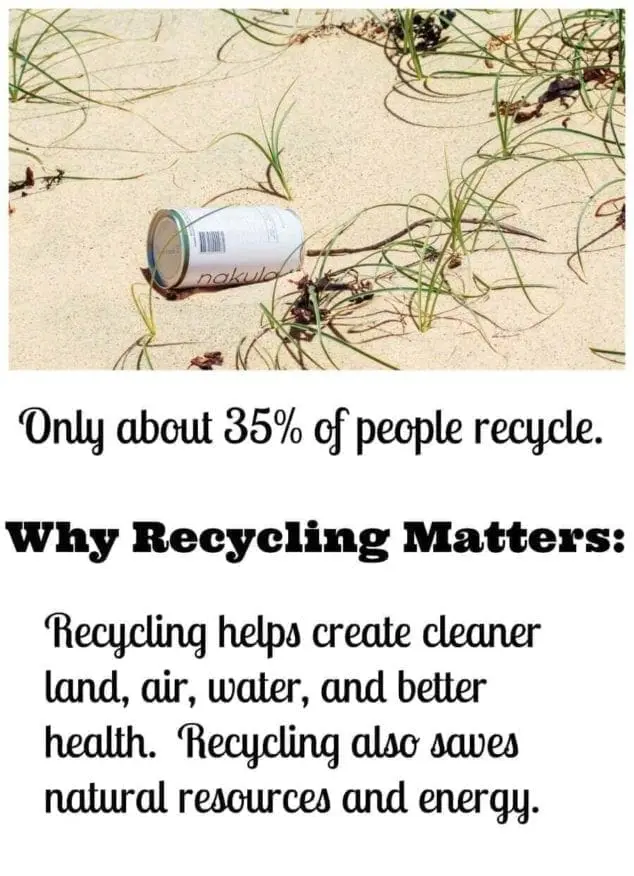
Recycle
Make recycling a habit. It may seem basic but recycling is still so often overlooked (according to the United States EPA in 2015, only 34.7% of people recycled). Every kitchen and home office should have a recycling bin. Every time you go to throw something away, ask yourself if it can be recycled instead. See these recycling tips for more info.
Recycling helps create cleaner land, air, water, and better health. Recycling also saves natural resources and energy. Does recycling really matter? Yes! Here is one small statistic to show you that even one can or bottle does have a positive impact:
“Tossing one aluminum can in a recycling bin takes a matter of seconds, but it can save a great deal of energy. As a matter of fact, it’s estimated that recycling a single aluminum can will save enough energy to power a TV for up to three hours.” –Recycle Nation
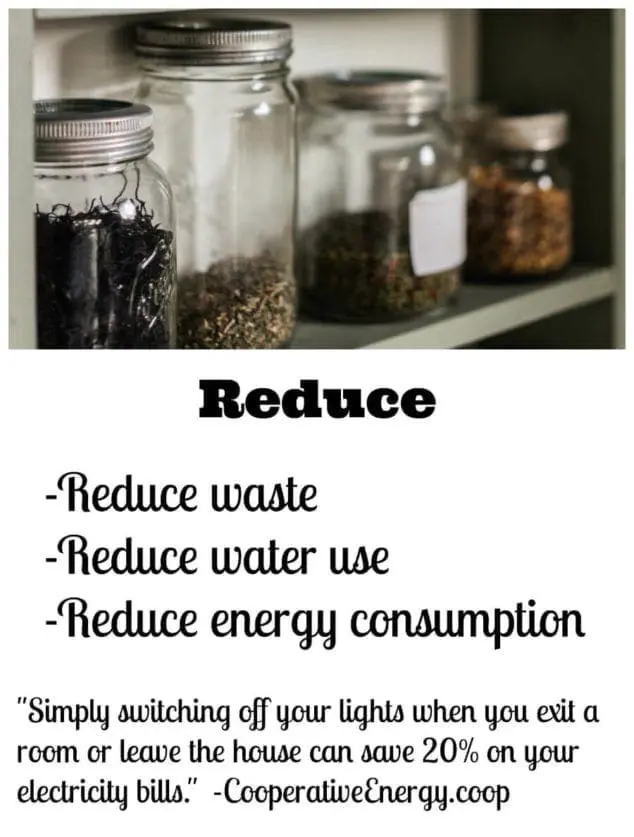
Reduce
Another easy green habit is to reduce your waste. Buy things in bulk to avoid excessive packaging and waste. Reduce your water use. Make sure you are turning off the water while you brush your teeth, only water your yard in the morning, only run full loads in the dishwasher and clothing washer. Reduce your energy use. Turn off lights when they are not in use. Don’t keep your thermostat set too low or too high. Try two degrees higher in the summer and two degrees lower in the winter. Try washing your clothes in cold water. It uses about 90% less energy and most detergents are made for this now.
Here is a statistic to inspire you to reduce your consumption:
“Simply switching off your lights when you exit a room or leave the house can save 20% on your electricity bills.” -CooperativeEnergy.coop
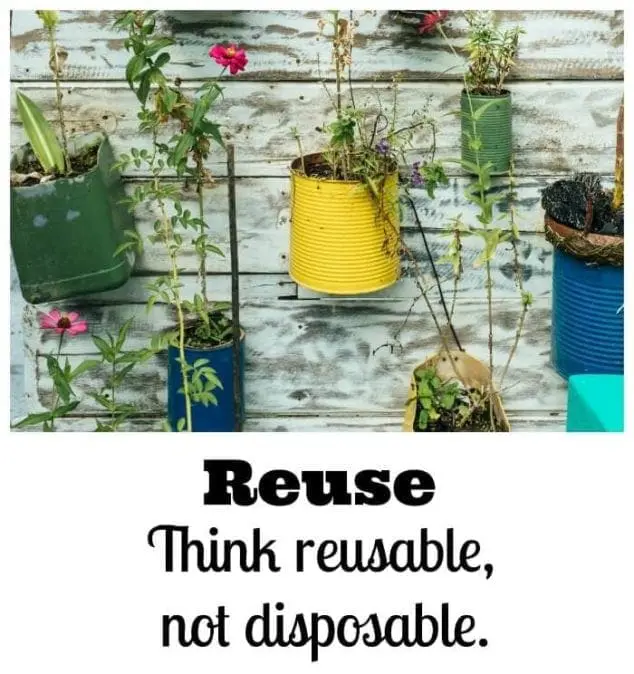
Reuse
Being sure to reuse things is another green living habit that really makes a difference. Instead of disposable things, try using reusable things. Get a good reusable water bottle and some reusable containers to pack lunches, snacks, and leftovers. If you like to combine fashion with function, check out resuable bottles and food containers from S’well for the most on trend but still practical reusable containers you will love. Keep reusable bags in your car so you are prepared at the grocery store. Use reusable towels and sponges instead of paper towels. You can even reuse your kitchen scraps and turn waste into compost for your garden.
Inspring reuse stats:
“The use of a $20 BPA-free reusable water bottle can save the average American $6,180 after five years of use, which is the bare minimum life expectancy of a reusable water bottle. If one person switches to using a reusable water bottle, 217 plastic water bottles will be saved from going to a landfill that year. Not only do they save you a lot of money and help the environment, but they are also a healthier option as opposed to plastic water bottles.” – Mathematics For Sustainability

Green Living Tips For Shopping
How you shop is an important part of green living as well. You are basically voting with your wallet and putting your money where your mouth is. I will break my green living ideas for shopping into 3 areas: green choices for the home itself, green cleaning products for the home, general green shopping tips.

Green Choices For The Home
From little things that you buy for your home, like recycled paper towels, to big things, like energy star appliances, there are lots of ways to keep your home more eco-friendly. For instance, you might want to think about speaking to a home window replacement contractor. This is a great way to ensure that you aren’t spending as much heating or cooling your home because it stop air escaping or entering. There is a greener version of almost everything you can think of. So when it comes time to replace things, always look for the most eco-friendly option. Here are just a few ideas:
- Recycled paper towels
- Faucet aerators
- High-efficiency heads for your bathroom shower
- High-efficiency lighting
- No-VOC paints
- Rain barrels
- Energy Star appliances for energy efficiency
- Energy Star Windows- or even caulking and weather stripping around old windows
- Renewable energy or solar power
An inspirational Green Shopping For The Home Stat:
“The average US household can save about 2,900 gallons of water every year simply by installing a single low-flow showerhead. Just one will make that much difference. Multiply that by the number of bathrooms in every house in every town of every state. The impact is overwhelming.” –HGTV
Lowing our water consumption and increasing our water conservation not only protects our clean water supply but also reduces energy consumption treating and transporting less water.

Green Cleaning Products
So another area for the home where our shopping makes a big difference is the cleaning supplies we chose. If you are interested in green living, start using eco-friendly cleaning products. The benefits of a green cleaning routine include reducing exposure to toxic chemicals. Additionally, you will be improving overall indoor air quality by reducing airborne dust and chemical gases. Not only is green cleaning important for us in our homes, it also results in less environmental pollution. It helps to minimizee your impact on ozone depletion.
The EPA suggests, “choosing less hazardous products that have positive environmental attributes (e.g., biodegradability, low toxicity, low volatile organic compound (VOC) content, reduced packaging, low life cycle energy use)”. Next time you need to replace a cleaning supply, try a greener version. I bet that you will like that they work just as well and are safer!

General Green Lifestyle Shopping Tips
Since my piece today is focused around green living ideas for the home, I don’t want to get into too many details for green shopping tips. However, I must mention that you can chose to green almost everything you bring into your house. Buy organic products, seasonal foods, and natural products when possible. Try used goods, upcycled things, and things are made well to last a long time. Consider giving eco-friendly gifts.

Statistic to make you show you the power of your purchases:
“Organic agriculture can reduce the need of fossil fuel for crop production by 70 percent. If used worldwide, organic farming could store CO2 by an amount corresponding to a global emission reduction of 40 percent.” – The World Counts
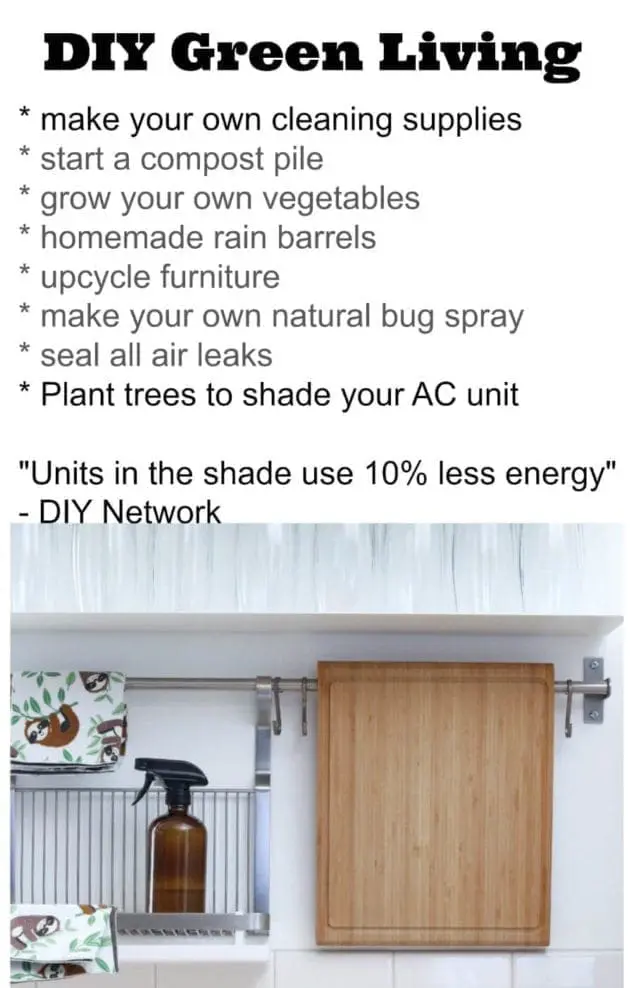
DIY Eco Friendly Products
Another part of green living is adopting DIY methods and recipes that work for you. If you can make a recipe at home, whether for food or cleaning products or even beauty products, chances are it is more eco-friendly. This is due to the fact that you can use organic ingredients and you can reduce waste and transportation. So go ahead an leave the harsh chemicals behind and make sure your home is a healthy environment.
DIY Living Green Ideas & Recipes
There are so many DIY green living project ideas. Here are just a few:
- making your own cleaning supplies
- start a compost pile
- growing your own vegetables
- homemade rain barrels
- making furniture from discarded pallets
- make your own natural bug spray
- seal all air leaks with caulk or weather stripping
- Plant trees to shade your air conditioning unit, but not block air flow. “Units in the shade use 10% less energy to operate.” – DIY Network
Sustainable Lifestyle Pins To Inspire
Sustainable living can be pretty and fun too! Check out my Eco Tips Pinterest Board for lots of inspirational green living pins! A sustainable lifestyle involves minimizing the amount of waste you produce by reusing items, recycling, composting organic materials, and avoiding single-use products.
Conclusion
Part of your commitment to a sustainable lifestyle is choosing products that are made from sustainable materials, are biodegradable, or have minimal packaging helps reduce environmental impact. Green living also encourages the use of energy-efficient appliances, reducing energy consumption, and utilizing renewable energy sources like solar or wind power. Furthermore, sustainable living involves adopting practices like using water-saving fixtures, fixing leaks, and collecting rainwater can help conserve water.
You can really find endless ideas for incorporating green living into your life. Take it one step at a time. We can’t fix climate change in a a day but we can pick a few green habits to incorporate daily. Pick a few new green items to buy at the store. See if you can find a DIY green living project that inspires you. Do what works for you. Then just keep adding in a few new green habits and shopping choices every couple of weeks. I think you are going to love this whole green living movement. It is something you can feel great about! By adopting these practices, individuals can contribute to a healthier planet and a more sustainable future.
I hope you enjoyed these tips on living green. What was your big take away? Share your green living ideas or questions @familyfocusblog!
Related Posts:

Gary says
Don’t get me wrong, I’m not against green living, but we need to realize that sometimes green activities aren’t as green as we hope. You have to do your research to make sure the positives really do outweigh the negatives. Thanks for sharing these sustainable living ideas.
Minahil says
Thanks for discussing green living meaning. I appreciate your attention to detail in everything you do. Please continue to work at the high standards you have. You set a wonderful green living example for others.
Alexandra says
Good article to inspire sustainable living. There were several new eco friendly living ideas here that I plan to implement and every bit matters.
Cutting Edger says
Love these green living tips! They’re practical and easy to implement. Small changes can really make a big difference. Thanks for the inspiration to live more sustainably!
Dubai says
Thanks for sharing how to live a sustainable lifestyle. I especially appreciate the attention to small changes that together can lead to significant environmental benefits, such as reducing energy consumption and choosing eco-friendly products, it’s nice to know that even simple actions can contribute to a greener lifestyle. I love to see companies embracing changes too like incorporating green living principles into real estate, especially when it comes to designing or renovating buildings to be more environmentally friendly.